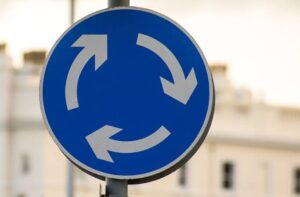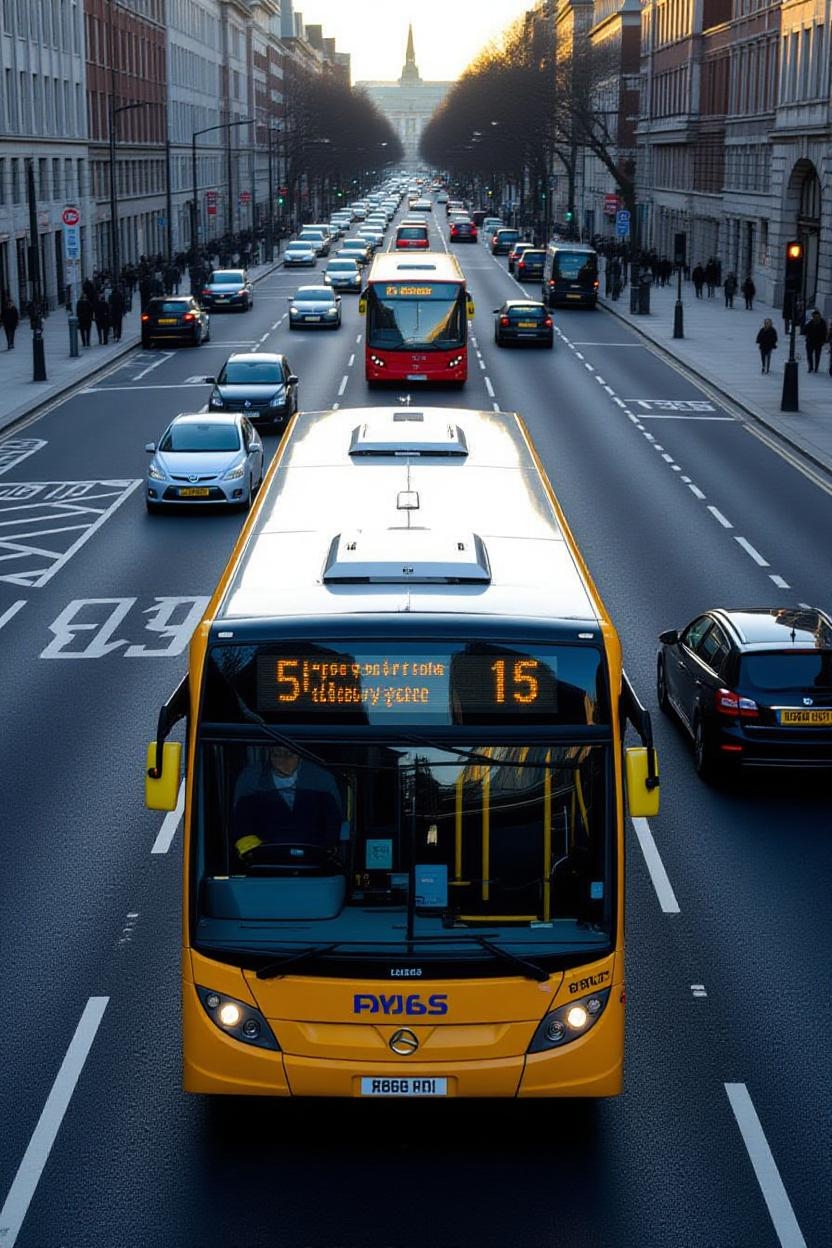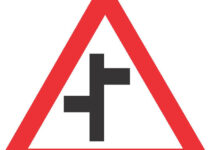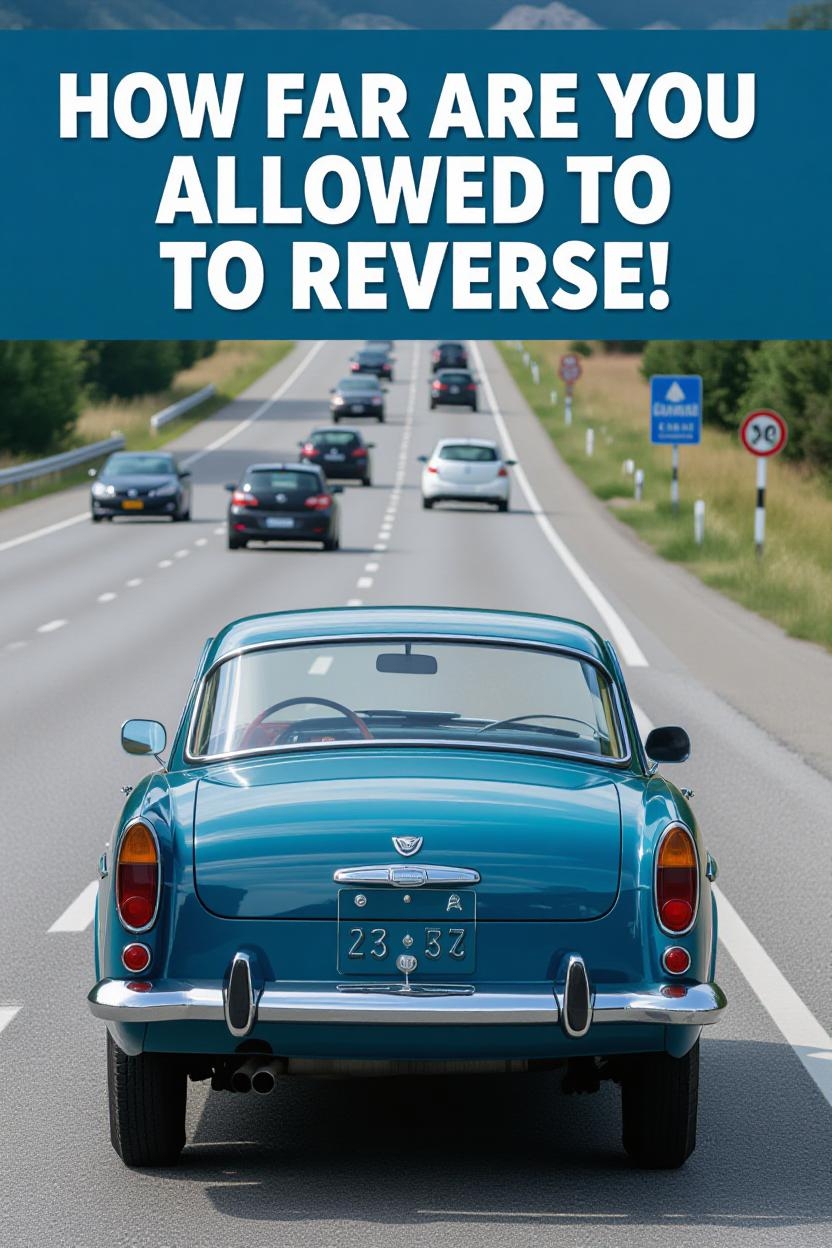Different Roundabout And Mini Roundabout Signs
Mini Roundabout Sign, All You Should Know.
The mini roundabout sign is a distinct traffic control device used to alert drivers to a compact, circular intersection designed for low-speed traffic management, often in tight urban or residential settings.
Unlike descriptions you might find on typical blogs, which often focus on standard roundabouts or generic traffic signs, let’s break down the mini roundabout signs unique role and design with a fresh perspective, emphasizing its function and context without leaning on common online narratives.
How Does A Roundabout Sign Looks Like?
The roundabout sign itself is typically a circular symbol with a red border, containing three white arrows curving in a circular pattern, indicating the direction of traffic flow—counterclockwise in countries where driving is on the right, like the US or Nigeria.

This distinguishes it from other traffic signs, such as yield or stop signs, which don’t convey the circular motion of a roundabout.
Unlike larger roundabouts, which often have more elaborate signage (e.g., with lane markings or destination arrows), the mini roundabout sign is minimalist, reflecting the smaller scale and simpler layout of the intersection it governs.
Mini roundabouts are unique because their central island is often fully traversable (painted or slightly raised) rather than a physical barrier, allowing larger vehicles like buses or trucks to pass over it.
The sign’s purpose is to prepare drivers for this compact setup, where quick decision-making is key due to the tighter radius—sometimes as small as 15-25 feet in diameter.
The sign doesn’t just say “slow down”; it implicitly warns of a dynamic where drivers must yield to circulating traffic and navigate a constrained space, often with less room for error than at larger roundabouts.
What sets the mini roundabout sign apart from other intersection controls is its emphasis on continuous flow in a confined area.
Unlike a four-way stop or traffic light, which halts traffic, the mini roundabout sign signals a system where yielding and merging happen on the fly, prioritizing efficiency in low-traffic, low-speed zones.
It’s less about commanding a stop and more about choreographing a smooth, cooperative dance of vehicles.
In contrast to blog descriptions that might overgeneralize roundabouts as “big circles with lots of signs,” the mini roundabout sign is a specific cue for a scaled-down, often retrofitted intersection that maximizes space and safety without the infrastructure of larger systems.
The sign’s design also carries subtle psychological cues. Its circular shape mirrors the intersection itself, visually priming drivers for the curved path ahead. In some regions, supplementary signs (e.g., “Yield” or “Mini Roundabout Ahead”) may accompany it, but the core symbol is universal in many countries, rooted in international traffic sign conventions.
Unlike stop signs, which are octagonal and red to scream “halt,” or yield signs, which are triangular and often white or yellow, the mini roundabout sign’s circular form and arrow pattern are uniquely tied to the fluid, cyclical nature of the intersection.
In essence, the mini roundabout sign is a concise, visually intuitive signal that governs a specialized intersection type.
It’s not just about directing traffic but about enabling a compact, efficient, and safe flow in spaces where larger roundabouts or traditional intersections wouldn’t fit.
Its design and function are tailored to the unique dynamics of mini roundabouts, making it a critical tool for modern urban traffic management.
What Does A Roundabout And Mini Roundabout Sign Indicate?
A roundabout sign and a mini roundabout sign both indicate the presence of a circular intersection where traffic flows in a single direction around a central island, but they differ in scale, context, and specific implications for drivers.
Here’s a clear breakdown of what each sign indicates, tailored to avoid generic blog-like explanations and provide a precise, practical understanding:
Roundabout Sign
Appearance: Typically a circular sign with a red border and three white arrows forming a loop, indicating the direction of traffic flow. In some regions, it may be accompanied by additional signs, such as lane-use arrows or destination indicators.
What It Indicates:
- Circular Intersection: Alerts drivers to a full-scale roundabout, a traffic control feature designed to manage moderate to high traffic volumes at intersections, often with multiple lanes and a non-traversable central island (e.g., landscaped or raised).
- Yield Requirement: Drivers must yield to traffic already circulating in the roundabout and merge when safe. This ensures continuous flow without stopping unless necessary.
- Higher Speeds and Complexity: Roundabouts are larger (often 50-200 feet in diameter), handling higher speeds (20-40 mph) and potentially complex traffic patterns, especially at multi-lane roundabouts.
- Navigation Prep: The sign prompts drivers to choose the correct lane (if multi-lane), slow down, and be prepared for multiple entry/exit points, often guided by additional signage or road markings.
- Safety and Efficiency: Signals a system prioritizing smooth traffic flow and reduced collision risk, particularly at busy intersections, by eliminating the need for traffic lights or stop signs in many cases.
Mini Roundabout Sign
Appearance: Similar to the roundabout sign, it’s a circular sign with a red border and three white arrows in a loop, but it specifically denotes a smaller-scale intersection. It may include a supplementary “Mini Roundabout” or “Yield” sign in some regions.
What It Indicates:
- Compact Circular Intersection: Marks a mini roundabout, typically found in urban or residential areas with lower traffic volumes. These are smaller (15-25 feet in diameter) with a fully or partially traversable central island (often painted or slightly raised) to accommodate larger vehicles.
- Yield and Tight Navigation: Drivers must yield to circulating traffic and navigate a tighter circle, requiring slower speeds (10-20 mph) and heightened awareness due to the compact layout and limited visibility.
- Space Efficiency: Indicates a traffic solution for confined spaces where a full roundabout or traditional intersection (e.g., stop signs or lights) isn’t feasible. Often retrofitted into existing intersections.
- Quick Decision-Making: The sign cues drivers to be ready for rapid merging and exiting in a smaller space, with less room for error compared to larger roundabouts.
- Low-Speed Safety: Emphasizes safety in low-traffic, low-speed environments, reducing the need for stops while managing minor intersections effectively.
Key Differences in What They Indicate
- Scale and Context: The roundabout sign points to a larger, often more complex intersection handling higher traffic volumes, while the mini roundabout sign indicates a smaller, simpler setup for low-traffic, space-constrained areas.
- Central Island: Roundabout signs imply a non-traversable island, while mini roundabout signs often indicate a traversable or painted island, affecting how larger vehicles navigate.
- Speed and Complexity: Roundabout signs prepare drivers for potentially higher speeds and multi-lane navigation, while mini roundabout signs signal slower, single-lane circulation with tighter turns.
- Driver Behavior: Both require yielding, but the mini roundabout sign demands more caution due to the compact size and quicker reaction times needed.
Shared Indications
- Circular Flow: Both signs indicate a continuous, one-way traffic flow around a central point, requiring drivers to yield to vehicles already in the roundabout.
- Safety Focus: Both aim to reduce collisions and improve traffic flow compared to traditional intersections.
- Universal Symbol: The circular shape with looping arrows is a consistent visual cue, rooted in international traffic sign standards, priming drivers for the roundabout’s layout.
Summary

In summary, the roundabout sign prepares drivers for a larger, potentially multi-lane circular intersection with broader traffic management goals, while the mini roundabout sign signals a compact, low-speed version designed for tight spaces and simpler traffic patterns.
Both guide drivers to yield, merge, and navigate circularly, but the mini roundabout sign emphasizes caution in a constrained environment.
Frequently Asked Questions?
1. What should I do when I see a roundabout or mini roundabout sign?
- Answer: Slow down, prepare to yield to traffic already in the roundabout, and merge into the circular flow when safe. For roundabouts, choose the correct lane (if multi-lane) based on your exit. For mini roundabouts, navigate the tighter circle cautiously, as space is limited and turns are sharper. Always yield to vehicles on your left (in right-side driving countries) and signal your exit.
2. How do I know if it’s a mini roundabout or a regular roundabout?
- Answer: The sign itself may include “Mini Roundabout” text or be accompanied by a smaller yield sign. At the intersection, mini roundabouts have a smaller diameter (15-25 feet) and often a painted or low, traversable central island, unlike the larger, non-traversable islands of regular roundabouts (50-200 feet). The mini roundabout sign signals a compact, low-speed setup.
3. Do I need to when I see a roundabout or mini roundabout sign?
- Answer: No, you don’t stop unless necessary to yield to circulating traffic. Both signs indicate a continuous flow system where you slow down, yield to vehicles already in the roundabout, and merge when there’s a safe gap. Stopping is only required if traffic conditions demand it.
4. Are mini roundabouts safe for large vehicles like buses or trucks?
- Answer: Yes, mini roundabouts are designed with traversable central islands (often painted or slightly raised) to allow larger vehicles to pass over them. The mini roundabout sign alerts drivers of this compact setup, so large vehicles can navigate by driving over the island if needed, though extra caution is required due to tight spacing.
5. Can pedestrians or cyclists use roundabouts and mini roundabouts?
- Answer: Yes, but the signs are primarily for drivers. Pedestrians and cyclists should use marked crosswalks or paths, often located a short distance from the roundabout or mini roundabout. Drivers must yield to pedestrians at crossings, but the signs themselves don’t directly address non-vehicular traffic.
6. What happens if I miss my exit in a roundabout or mini roundabout?
- Answer: Continue circling until you reach your desired exit. In a regular roundabout, stay in your lane and signal your exit. In a mini roundabout, the smaller size means you’ll circle quickly, so stay alert to avoid confusion. The signs prepare you for continuous flow, so missing an exit just requires another loop.
7. Are roundabout and mini roundabout signs the same worldwide?
- Answer: The core design (circular with three arrows) is based on international standards, like those from the Vienna Convention on Road Signs, but variations exist. Some countries add text (e.g., “Mini Roundabout”) or use different colors (e.g., blue background in some regions). Always check local traffic rules for specific meanings.


